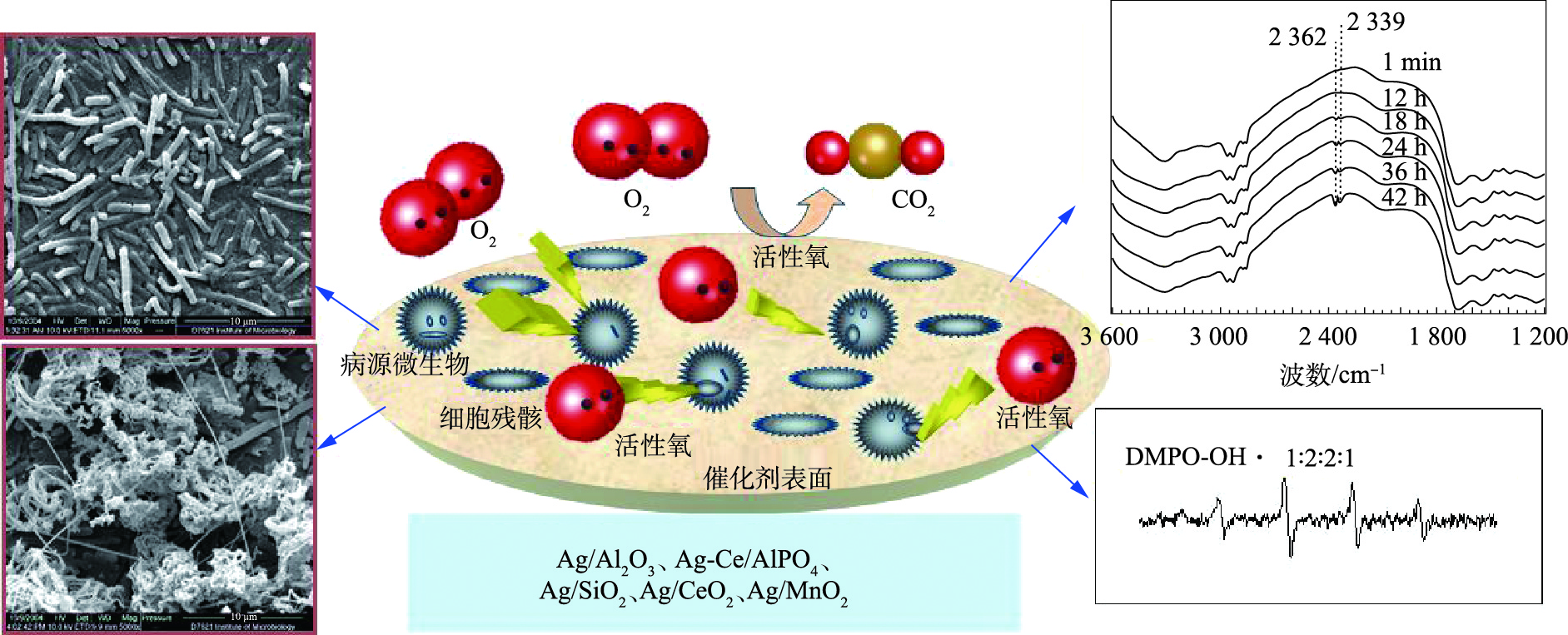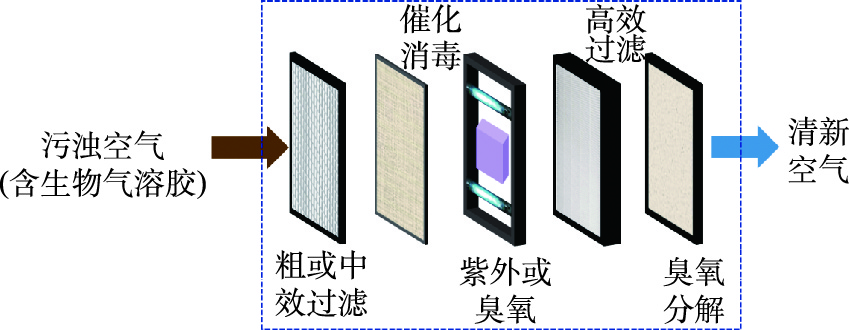-
气溶胶是指固体或液体颗粒物均匀地分散在气体中形成的相对稳定的悬浮体系,其动力学直径为1 nm~100 μm。生物气溶胶是含有生物性粒子的气溶胶,包括细菌、病毒以及致敏花粉、霉菌孢子、蕨类孢子和寄生虫卵等,具有传染性和致敏性。当病人在进行呼吸活动的时候,会产生携带大量病原体的飞沫。飞沫在空气中悬浮的过程中会失去水分,剩下的蛋白质和病原体组成核,就形成了生物气溶胶。生物气溶胶可在空气中悬浮较长时间,造成远距离传播。人类大部分活动都是在室内进行的,由生物气溶胶引发的疾病越来越多。全球约20%的呼吸道感染疾病是由其引起的[1]。曾经肆虐全球的非典病毒(SARS病毒)就是一种通过气溶胶形式进行传播的典型传染性病毒[2]。此后,国内外相继出现了禽流感、甲型和乙型流感和手足口病等通过气溶胶进行传播的传染性疾病[3]。
目前,新型冠状病毒肺炎(COVID-19)疫情正在全球范围内大规模爆发。研究发现,导致这次疫情的新型冠状病毒与SARS-CoV具有相似性,并且该病毒比SARS更具传染性[4]。新型冠状病毒的主要传播途径包括呼吸道飞沫传播和接触传播。而气溶胶传播作为一种可能的传播途径也备受关注。国家卫生健康委员会在发布的《新型冠状病毒肺炎诊疗方案(试行第七版)》中提到:“在相当密闭的环境中长时间暴露于高浓度气溶胶情况下存在经气溶胶传播的可能。”因此,认识生物气溶胶来源、危害及其传播规律,有助于采取有效措施降低室内环境的传染以及交叉感染风险。本研究通过比较主要消杀技术的优势及局限性,总结SARS冠状病毒疫情期间有效消杀技术的经验,提出室内空气高效滤除与杀灭病原体措施的方案建议。
全文HTML
-
居室、医院、办公室、船舶、高铁和飞机等室内环境空气中主要有病毒、细菌和霉菌气溶胶。不同室内环境的空气中,生物气溶胶的种类、数量以及所占的比例均不相同。医院是生物气溶胶浓度最高的地方。室内生物气溶胶的来源分为室内和室外源,主要来自室内人和动物的活动、物体表面(马桶、地毯、吸尘器、水面墙壁等)、空调、室外植物花粉、废水和固废处理等[5]。
-
当病人在进行呼吸活动的时候,会产生携带大量病原体的飞沫。随后飞沫会在空气中传播,即空气飞沫传播,是空气传播的一种方式。一般情况下,空气飞沫传播只有与传染源近距离接触才可能实现,而距离传染源1 m以外是相对安全的,距离2 m以上安全性更高。因为没有外部条件(如风力)的帮助,飞沫喷射到2 m以外的可能性非常小。然而,飞沫在空气传播过程中会雾化成生物气溶胶,该过程会受到各种环境因素的影响。随着时间的推移,生物气溶胶逐渐丧失活性。影响飞沫中病原体生存的因素包括飞沫中的介质、温度、湿度、氧敏感性以及紫外、臭氧或电磁辐射等[6]。相关学者也开展了飞沫颗粒大小与传播距离的关联性的研究。研究[7]表明,直径大的飞沫会很快落到地面上,中等大小的飞沫,尤其是直径小于5 μm的飞沫会扩散到空气中,以气溶胶的方式传播,传播路径见图1。如果病原体在传播过程中没有丧失活性且被易感染人员吸入一定剂量,那么就可能造成疾病感染。
-
室内生物气溶胶病原体对人体健康具有很大的危害,可引起人体自身免疫系统和超敏反应[8],重则导致死亡。近年来病毒性疾病暴发频繁,如冠状病毒导致SARS疫情的爆发;呼吸道合胞病毒造成的流感肆虐;源于啮齿类动物粪便的汉坦病毒引发的肺炎等[9],导致高的死亡率。细菌性气溶胶致人感染的风险也很高,人类即使暴露在较低浓度的军团菌病、化脓性链球菌结核病、炭疽热等细菌生物气溶胶也容易感染。芽枝霉菌、曲霉菌、青霉菌以及链格孢菌这4类真菌气溶胶大量存在于室内空气中,容易引起哮喘和鼻炎等疾病。
-
生物气溶胶的源头是飞沫。飞沫中病原体的存活受多种因素影响。直径小的飞沫容易以气溶胶的方式传播,并且积累到一定浓度容易造成人的感染。根据生物气溶胶的传播特征,生物气溶胶最常用的防控措施主要有如下3个方面:一是要正确佩戴口罩、护目镜、穿隔离服等,堵断生物气溶胶的飞沫传播;二是要通风,降低生物气溶胶的浓度。由于空气的稀释作用,生物气溶胶致病的几率大大降低;三是要定期消毒。室内需要定期用含氯类(如84消毒液、漂白粉)消毒剂进行喷洒消毒;用酒精类的如75%酒精擦拭常用物品表面进行消毒。然而,上述防控措施存在操作的局限性:长期佩戴口罩会非常不舒服,还可能导致面部皮肤损伤;有些办公、居家、公共交通工具等环境内不具备良好的通风和消毒条件等等;尤其在医院及公共场所,人员流动频率高,在无人情况下的消毒方法十分有局限性且没有持续性。因此,这就需要采取其他高效、安全、可行的消杀措施,实现在有人员流动的情况下对室内空气中病原体的消杀,确保人们的健康安全。
1.1. 生物气溶胶种类和来源
1.2. 生物气溶胶的传播方式
1.3. 室内空气中生物气溶胶的危害
1.4. 对生物气溶胶的防控措施
-
空气中细菌和病毒的消杀技术,大体上可分为物理和化学方法两大类,包括热、过滤截留、紫外线、臭氧及催化技术等。
-
通过加热的方法可以使微生物中的蛋白质和核酸物质变性,从而有效地杀灭各种病原体,如各类细菌、真菌和病毒。热消杀技术应用广泛,并且效果可靠。不同微生物对温度的耐受性存在差异,微生物繁殖的温度范围为−10~90 ℃。当加热温度达到56 ℃时,每15 min会有10 000个SARS冠状病毒被杀灭[10]。新型冠状病毒对温度也很敏感,56 ℃下加热30 min即可灭活[11]。但受物体的耐高温性和应用场所的限制,热消杀方式应用起来也存在诸多缺点。
-
空气过滤消毒指用物理阻留的方法去除空气中的病原体,包括细菌与病毒。针对不同病原体的尺寸,通常用不同孔径滤材对生物气溶胶进行过滤,其过滤效率与滤材的孔径密切相关。通常孔径越小,过滤效率越高,但是引起的空气阻力也会变大。与细菌相比,病毒的直径要小很多。因此,为了高效过滤病毒,必须使用孔径小的高效滤材[12-13]。近年来,除了广泛使用的HEPA等过滤材料外,静电纺丝也成为能有效过滤消毒的新型材料,广泛应用于含有滤材的口罩、空气净化器和新风过滤系统等。该技术的优点是在室温下就可以去除空气中的病原体,操作简易;缺点是只能起到过滤的作用,并不能杀灭微生物,可能为微生物繁殖提供温床,造成二次污染。
-
紫外线消毒指利用波长220~300 nm的紫外线破坏微生物机体细胞中的DNA或RNA的分子结构[14],将各种细菌、病毒、寄生虫以及其他病原体直接杀死。这是最常用的密闭空间内生物气溶胶消杀技术。紫外线消毒速度快、效率高,并且几乎对所有的细菌、病毒都能有效灭活。紫外杀灭病原体的作用取决于照射剂量、空气的水分含量、空气运动模式以及密闭空间的大小。常规应用需要照射无死角并且达到照射剂量才能达到杀菌消毒的效果。据报道,新型冠状病毒等各种病毒也对紫外线敏感。紫外线由于其良好杀毒性能及功效,已经在多种场景下取得了广泛应用,例如在医院病房、手术室、无菌实验室等对环境要求较高的场所。紫外线消毒技术的应用已经相对纯熟,但是紫外线对人体有害,不能直接暴露应用在有人员活动的场所。
-
臭氧是一种强氧化剂,可直接氧化胞内有机物,遇到水蒸气可以产生强氧化性的羟基等自由基间接氧化病原体,从而达到杀菌消毒目的。在20 m3的气雾室内产生50 mg·m−3的臭氧可对人工污染的空气中的白色葡萄球菌杀灭99.96%以上;在60 m3的密闭房间产生10 mg·m−3的臭氧可对空气中的自然菌杀灭93%以上[15]。臭氧消毒为溶菌级方法,杀菌彻底,具有杀菌广谱、高效的特点,对所有细菌和病毒都有明显的杀灭效果。臭氧在应用于室内消毒杀菌取得很好效果的同时,残余的臭氧浓度过高,会对人体造成危害,因此需采取有效措施抑制臭氧释放与残留。臭氧消毒技术具有高效性、广谱性和便捷性的特点。
-
催化消杀技术是利用活性高、寿命长的催化剂进行杀菌消毒,包括光催化和非光催化杀菌技术。光催化杀菌技术主要是利用光催化剂在光的作用下产生活性氧物种(reactive oxygen species,ROS)和自由基氧化微生物达到杀灭效果。众多的研究表明,TiO2光催化杀灭微生物技术具有效果好、作用迅速等特点。但是由于TiO2带隙较宽,只能利用占太阳光不到5%的紫外光,同时活性受光照强度等条件影响。SAWAI等[16-17]连续多年对MgO和CaO等氧化物的常温杀菌消毒性能进行研究,取得了很多有价值的成果。他们否定了CaO与MgO的杀菌机理主要是利用其碱性的观点,证明这些氧化物的杀菌机理与活性氧的产生有关;并通过在CaO和MgO粉末胶体中加入超氧歧化酶或同时加入超氧歧化酶和过氧化氢酶等活性氧捕捉剂,采用荧光法检测到的活性氧信号的变化,充分证明了活性氧自由基·O2-和H2O2在杀菌过程中发挥的重要作用,为非光催化氧化杀菌机理提供了有力的支持[16-17]。
-
通过耦合两种或两种以上技术可以提高室内空气中细菌和病毒的杀灭效率,减少二次污染等技术弊端。国内已有学者着手开展了复合技术用于室内空气病原体消杀的探索研究,发现在同样的条件下,臭氧耦合二氧化钛复合技术的消杀效率比单一技术效果好[18]。紫外线联合臭氧催化技术在生物气溶胶模拟现场以及储物室和卫生间等实际现场测试的结果表明,该耦合技术的室内杀菌消毒效果优异,具有很好应用前景[1]。
2.1. 热消杀
2.2. 过滤消毒
2.3. 紫外线消毒
2.4. 臭氧消毒
2.5. 催化消杀技术
2.6. 耦合消杀技术
-
2003年,为抗击“非典”疫情,控制SARS病毒的传播,中国科学院大连化学物理研究所刘中民等与大连医科大学病原学教研室合作成立了“抗病毒纳米催化材料研究”攻关小组。攻关组成员利用流感病毒等开展了“用于呼吸道病毒阻隔、吸附及灭活的纳米催化材料及相关作用机制研究”的工作,发现多种无机多孔固体催化材料对吸附在其表面的病毒具有明显的灭活作用,说明催化灭活微生物是普遍存在的现象[19]。这是国内外最早利用催化材料灭活SARS病毒的研究。
中国科学院生态环境研究中心贺泓院士课题组在非典期间开发的催化剂也被证实对SARS病毒具有高效杀灭效果[20],结果见表1。在空气中无需外加光电能源的人居条件下,Ag/Al2O3催化剂可在5 min内即可有效杀灭吸附于其表面的初始量为2×106 cfu.mL−1的多形德巴利酵母菌和大肠杆菌、初始量为105PFU (plaque forming unit)的杆状病毒和SARS冠状病毒。Cu/Al2O3催化剂在20 min内也可以有效杀灭大肠杆菌、杆状病毒和SARS冠状病毒。作为对照的Al2O3载体和滤纸则没有任何消杀效果。将该催化剂涂覆到空气净化器模块上,在30 m3的标准测试舱中测试后,发现其除菌率可以达到95%以上,极具推广应用潜力。在前期研究的基础上,课题组又开发了一系列不同晶型、不同形貌的载银催化剂,无需引入外加光源就呈现出优异的室温接触杀菌活性[21-28]。这一系列催化剂的杀菌机制为:通过活化分子氧产生具有高氧化性的ROS,同时结合溶出的银离子的毒性作用,导致细胞内活性氧的产生、细胞的破损乃至死亡。红外测量结果进一步显示,上述杀菌过程有CO2生成,证实了ROS参与的催化氧化杀菌及矿化过程(见图2),最终微生物脱离材料表面,进而重新露出具有杀菌消毒作用的催化材料表面,从而实现材料的重复使用。该催化材料在对空气杀菌和净化过程中不会对人体和生态环境构成任何伤害,具有广谱和高效等优点,非常适合室内的杀菌消毒。而且这种消杀方法的实施过程不会损耗光电能源,在室温条件即可实现,很具应用前景。
日本“钻石公主”号邮轮上1位乘客确诊感染了新型冠状病毒,之后邮轮上所有乘客均在海上隔离了十几天。2020年3月5日的新闻证实,隔离后仍然有696人感染。在我国湖南省,也发生了公共交通工具内新型冠状病毒肺炎聚集性疫情事件[29]。这些事例表明新型冠状病毒在通风不畅的室内环境中进行了传播与交叉感染。相比于室外具备阳光照射等不利于细菌和病毒存活的因素,室内环境中生物气溶胶的浓度较高,室内空气中的细菌和病毒通常也会存活得更久。因此,在居室、医院、隔离场所、火车、飞机、轮船和办公室等室内环境,应在采取通风、防护和消毒等措施的同时,加强室内空气中生物气溶胶的消杀,阻断病原体感染风险,从而控制病原体以及疫情的传播,保障人们的身心健康。目前,主要采用消毒剂以及紫外线的方式来杀灭新型冠状病毒。然而,这些方法仅适合用于物体表面或者特殊场所的消毒,亟需开发高效复合技术,比如能实现病毒高效过滤和原位灭活的复合技术、防护产品与净化装置,形成室内空气病原体消杀的整体解决方案。
现有空气净化设备和空调粗效或中效过滤材料对直径较小的病毒滤除效果不高,建议采用高效过滤材料和紫外、臭氧、室温高效催化剂等相结合的复合技术,实现对病毒的高效滤除和原位杀灭(见图3)。普通空气净化设备一般采用H11~H12等级的HEPA滤网,其对直径为0.3 μm以上的微粒去除效率可达到98%以上,是去除细颗粒物污染物最为有效的过滤材料。然而,病毒直径更小,并且要求的滤除效率更高,所以需要H13~H14等级的HEAP滤网。通过对室内生物气溶胶消杀技术的优劣势分析发现,紫外、臭氧和高效催化剂具有优异的杀灭病源微生物的能力。耦合紫外、臭氧和高效催化剂技术的优势,实现在高风量条件下对滤除病毒的高效杀灭,具有很好的可行性。基于此原理,贺泓院士团队与合作企业对传统空气净化器的结构进行改造,采用H13等级HEPA滤网,微生物拦截率可达99.9%;再将紫外灯管或臭氧发生装置置于HEPA滤网迎风面实现对过滤下来的微生物高效杀灭;同时末端采用高效催化分解材料分解残留臭氧,避免二次污染,为病原体的消杀和疫情的防控起到了积极的作用。近期在30 m3的监测舱内的检测结果证实,基于过滤、紫外光和臭氧耦合技术改造的空气净化器对空气中噬菌体病毒单位小时去除率达到99.9%。若将此净化器应用于新冠病毒的消杀,还需要在国家生物安全四级实验室进行新冠病毒滤除和灭活效果的验证。为提高技术的实用性与时效性,建议将复合技术涉及的材料进行集成与模块化,组装到现有的空气净化器、新风系统和空调系统等设备中。另外,过滤和室温高效消杀催化材料也可以进行复合,并与无纺布等材料进行成型处理,应用到口罩等防护产品中。依托复合消杀技术研发的净化设备与防护产品需尽快投入使用,在助力打赢新冠病毒疫情防控狙击战的同时,也为今后室内空气病原体消杀设备的研发与推广应用提供技术支持。
-
针对家居、办公室、疫区医院或公共场所等室内环境的空气净化,开发高效细菌和病毒等病原体的过滤和原位灭活技术与装置,并应用到中央空调、新风系统、空气净化器、分体空调或特殊场所的排风系统,实现对病原体的高效过滤和杀灭,将为室内空气生物气溶胶消杀和疫情的防控提供技术支撑,对于疫情的防控具有重要意义。目前,测试结果表明,该方案与建议具有很好的效果,是行之有效的。同时,与空气净化器、新风系统、空调系统和口罩等集成的过滤、消杀复合技术与设备,也非常值得室内环境中推广应用。




 下载:
下载:



